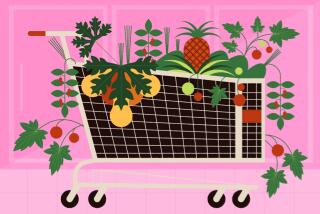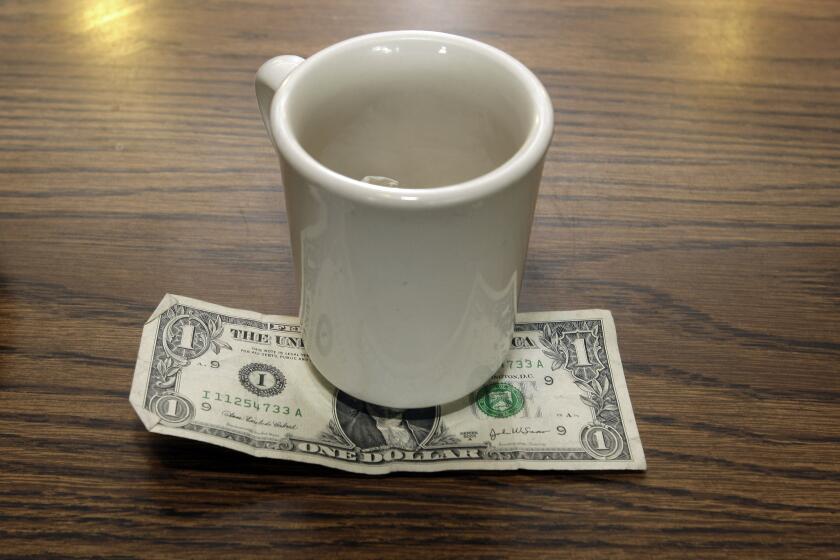Some Ways to Get a Head in Field of Gourmet Lettuce
- Share via
Though gourmet lettuce is expensive to buy in the market, it’s one of the easiest and most satisfying crops to grow.
Lettuce can be grown from seed, and some varieties come in six-packs at nurseries. Now through March is the perfect time to plant lettuce, as it thrives in cooler weather, said Deborah Woolley, assistant manager at Armstrong Garden Center in Santa Ana.
There are many lettuce types to choose from, including head and leaf lettuces, which come in a variety of shapes, colors and textures.
In six-packs, you’ll find ‘Bibb,’ small Iceberg, red leaf and romaine. In seeds you’ll find all of these, as well as ‘Buttercrunch,’ Grand Rapids leaf, ‘Black-seeded Simpson,’ ‘Prizehead’ leaf, bronze and Tom Thumb.
Some seed companies carry gourmet lettuce mixes, or you can create your own by combining seeds.
When you grow lettuce, you can harvest young, tender leaves, which tend to be sweet and mild, or wait until the lettuce matures and gets a stronger, more bitter flavor, Woolley said.
Lettuce is a quick grower. You’ll only need to wait about 20 to 30 days with transplants for your first salad. With seeds, the wait tends to run 40 to 60 days.
Woolley suggests keeping the following in mind:
* Choose transplants that are green and healthy and 3 or 4 inches tall. Smaller transplants are subject to damage when transplanted. If plants are small, let them mature for a week or two in the container. Don’t buy plants that have dried-out tips.
* Plant in a sunny location and make sure the site drains well. Amend to 8 inches with a soil conditioner, mulch or compost. If the soil is hard clay, replace half of it with amendment.
* Try containers. Lettuce is shallow rooted and doesn’t need a large space in which to grow. It is also an attractive container plant that looks good near the kitchen door. A 24-inch half barrel will provide a family of four with a steady supply of lettuce.
If space is limited, just about any pot will do, including color bowls, window boxes and hanging baskets. Use potting soil, and make sure the container has several drainage holes. If not, drill more.
* Put transplants at the same level they are in their containers.
* Sprinkle seed over a prepared bed and cover with a quarter-inch of fine soil. Water thoroughly with a fine mist so as not to disturb the seed. Keep misting on a regular basis until seedlings emerge, then switch to gentle spraying. When seedlings are 2 inches high, thin to 6 to 8 inches apart.
* Ensure a continuous supply of lettuce by sowing seed every two to three weeks.
* Lettuce needs a lot of nitrogen. Mix in a high nitrogen organic granular fertilizer when planting. After a month begin applying an organic liquid fertilizer such as fish emulsion every two weeks. Fertilizing is especially necessary when rains are heavy.
* Keep the soil evenly moist but not soggy. Watering should be frequent and light.
* Protect plants when Santa Ana winds are predicted, as they can quickly dry up tender lettuce leaves. Containerized lettuce should be moved to a sheltered location out of the wind. Where possible, set up a wind block for plants in the ground.
* Watch for pests, such as slugs, snails, earwigs and sow bugs. Handpick when possible.
If control measures are called for, try an organic pesticide such as horticultural diatomaceous earth, which can be found in some nurseries (not the type used for swimming pools). This is a powder that is harmless to humans but lethal to many pests, causing dehydration. Use sparingly, as it can also kill beneficial insects.
* Harvest head lettuce when small heads have formed. Harvest leaf lettuce as soon as it’s large enough to eat. Pull mature leaves off the outside, allowing the center to keep producing new leaves. When growth slows, harvest the whole plant.
January Planting Guide
Although January is one of our coldest months, there is still a lot of activity in the garden. It’s time to buy and plant bare-root roses, berries and fruit trees. There is also a variety of flowers and vegetables that grow well at this time of year. Keep in mind that because of the cool temperatures, seeds will take longer to germinate than package directions indicate.
Flowers (from seed or starter plants)
Alyssum
Calendula
Carnation
Dianthus
Dusty miller
English daisy
Iceland poppy
Nemesia
Pansy
Penstemon
Primrose
Santa Barbara daisy
Snapdragon
Stock
Sweet pea
Viola
Shrubs/Bare-root plants
Azalea
Camellia
Asparagus
Artichoke
Berries
Grape
Flowering tree
Fruit tree
Roses
Shade trees
Strawberry
Vegetables and herbs
Arugula
Beet
Broccoli
Brussels sprout
Cabbage
Carrot
Cauliflower
Celery
Endive
Garlic
Horseradish
Kale
Kohlrabi
Leek
Lettuce
Mustard greens
Onion
Parsley
Parsnip
Pea
Potato
Radish
Salsify
Spinach
Swiss chard
Turnip
Researched by Julie Bawden Davis / For The Times
More to Read
Eat your way across L.A.
Get our weekly Tasting Notes newsletter for reviews, news and more.
You may occasionally receive promotional content from the Los Angeles Times.










